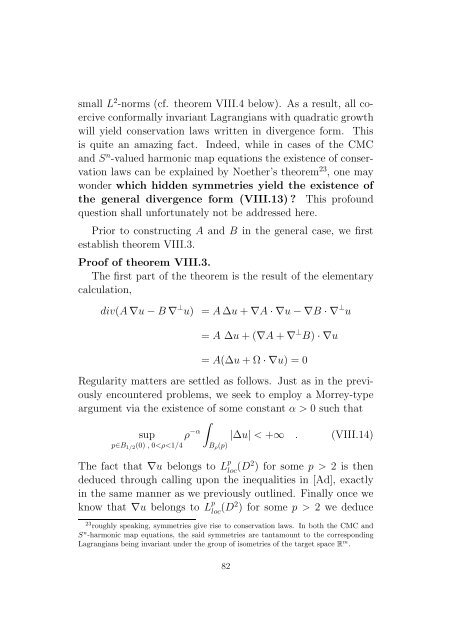Conformally Invariant Variational Problems. - SAM
Conformally Invariant Variational Problems. - SAM
Conformally Invariant Variational Problems. - SAM
Create successful ePaper yourself
Turn your PDF publications into a flip-book with our unique Google optimized e-Paper software.
small L 2 -norms (cf. theorem VIII.4 below). As a result, all coercive<br />
conformally invariant Lagrangians with quadratic growth<br />
will yield conservation laws written in divergence form. This<br />
is quite an amazing fact. Indeed, while in cases of the CMC<br />
and S n -valued harmonic map equations the existence of conservation<br />
laws can be explained by Noether’s theorem 23 , one may<br />
wonder which hidden symmetries yield the existence of<br />
the general divergence form (VIII.13)? This profound<br />
question shall unfortunately not be addressed here.<br />
Prior to constructing A and B in the general case, we first<br />
establish theorem VIII.3.<br />
Proof of theorem VIII.3.<br />
The first part of the theorem is the result of the elementary<br />
calculation,<br />
div(A∇u−B∇ ⊥ u) = A∆u+∇A·∇u−∇B ·∇ ⊥ u<br />
= A ∆u+(∇A+∇ ⊥ B)·∇u<br />
= A(∆u+Ω·∇u) = 0<br />
Regularity matters are settled as follows. Just as in the previously<br />
encountered problems, we seek to employ a Morrey-type<br />
argument via the existence of some constant α > 0 such that<br />
∫<br />
sup ρ −α |∆u| < +∞ . (VIII.14)<br />
p∈B 1/2 (0) , 0 2 we deduce<br />
23 roughly speaking, symmetries give rise to conservation laws. In both the CMC and<br />
S n -harmonic map equations, the said symmetries are tantamount to the corresponding<br />
Lagrangians being invariant under the group of isometries of the target space R m .<br />
82
















